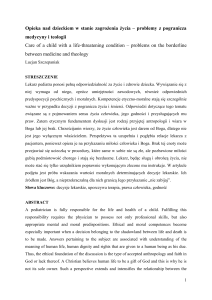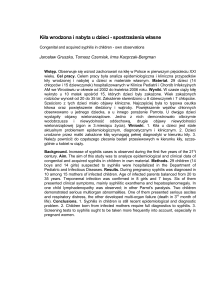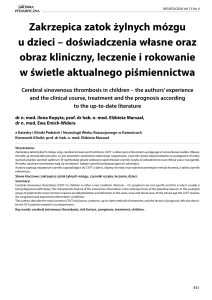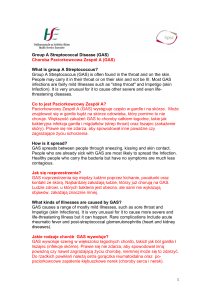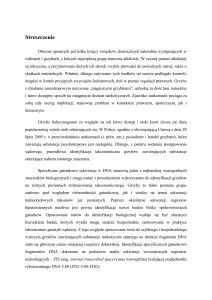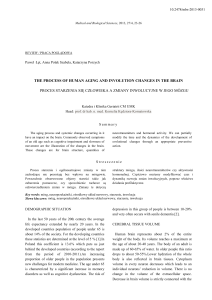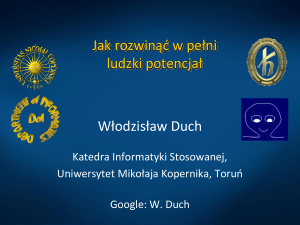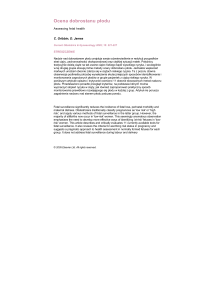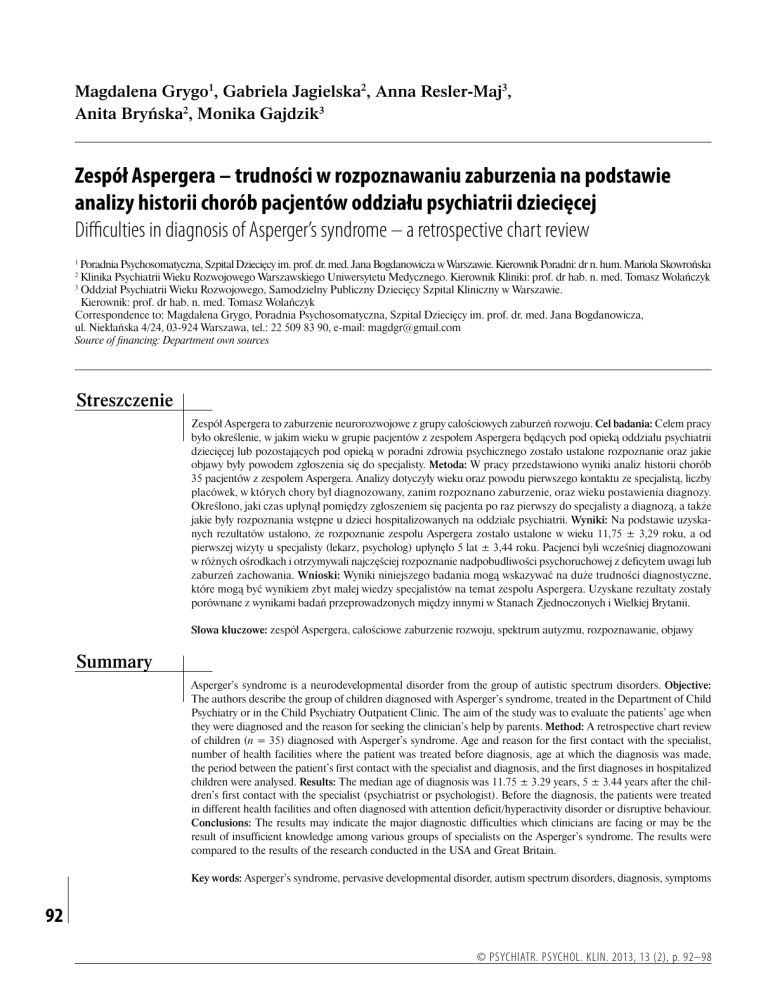
Magdalena Grygo1, Gabriela Jagielska2, Anna Resler-Maj3,
Anita Bryńska2, Monika Gajdzik3
Zespół Aspergera – trudności w rozpoznawaniu zaburzenia na podstawie
analizy historii chorób pacjentów oddziału psychiatrii dziecięcej
Difficulties in diagnosis of Asperger’s syndrome – a retrospective chart review
Poradnia Psychosomatyczna, Szpital Dziecięcy im. prof. dr. med. Jana Bogdanowicza w Warszawie. Kierownik Poradni: dr n. hum. Mariola Skowrońska
Klinika Psychiatrii Wieku Rozwojowego Warszawskiego Uniwersytetu Medycznego. Kierownik Kliniki: prof. dr hab. n. med. Tomasz Wolańczyk
3
Oddział Psychiatrii Wieku Rozwojowego, Samodzielny Publiczny Dziecięcy Szpital Kliniczny w Warszawie.
Kierownik: prof. dr hab. n. med. Tomasz Wolańczyk
Correspondence to: Magdalena Grygo, Poradnia Psychosomatyczna, Szpital Dziecięcy im. prof. dr. med. Jana Bogdanowicza,
ul. Niekłańska 4/24, 03-924 Warszawa, tel.: 22 509 83 90, e-mail: [email protected]
Source of financing: Department own sources
1
2
Streszczenie
Zespół Aspergera to zaburzenie neurorozwojowe z grupy całościowych zaburzeń rozwoju. Cel badania: Celem pracy
było określenie, w jakim wieku w grupie pacjentów z zespołem Aspergera będących pod opieką oddziału psychiatrii
dziecięcej lub pozostających pod opieką w poradni zdrowia psychicznego zostało ustalone rozpoznanie oraz jakie
objawy były powodem zgłoszenia się do specjalisty. Metoda: W pracy przedstawiono wyniki analiz historii chorób
35 pacjentów z zespołem Aspergera. Analizy dotyczyły wieku oraz powodu pierwszego kontaktu ze specjalistą, liczby
placówek, w których chory był diagnozowany, zanim rozpoznano zaburzenie, oraz wieku postawienia diagnozy.
Określono, jaki czas upłynął pomiędzy zgłoszeniem się pacjenta po raz pierwszy do specjalisty a diagnozą, a także
jakie były rozpoznania wstępne u dzieci hospitalizowanych na oddziale psychiatrii. Wyniki: Na podstawie uzyska‑
nych rezultatów ustalono, że rozpoznanie zespołu Aspergera zostało ustalone w wieku 11,75 ± 3,29 roku, a od
pierwszej wizyty u specjalisty (lekarz, psycholog) upłynęło 5 lat ± 3,44 roku. Pacjenci byli wcześniej diagnozowani
w różnych ośrodkach i otrzymywali najczęściej rozpoznanie nadpobudliwości psychoruchowej z deficytem uwagi lub
zaburzeń zachowania. Wnioski: Wyniki niniejszego badania mogą wskazywać na duże trudności diagnostyczne,
które mogą być wynikiem zbyt małej wiedzy specjalistów na temat zespołu Aspergera. Uzyskane rezultaty zostały
porównane z wynikami badań przeprowadzonych między innymi w Stanach Zjednoczonych i Wielkiej Brytanii.
Słowa kluczowe: zespół Aspergera, całościowe zaburzenie rozwoju, spektrum autyzmu, rozpoznawanie, objawy
Summary
Asperger’s syndrome is a neurodevelopmental disorder from the group of autistic spectrum disorders. Objective:
The authors describe the group of children diagnosed with Asperger’s syndrome, treated in the Department of Child
Psychiatry or in the Child Psychiatry Outpatient Clinic. The aim of the study was to evaluate the patients’ age when
they were diagnosed and the reason for seeking the clinician’s help by parents. Method: A retrospective chart review
of children (n = 35) diagnosed with Asperger’s syndrome. Age and reason for the first contact with the specialist,
number of health facilities where the patient was treated before diagnosis, age at which the diagnosis was made,
the period between the patient’s first contact with the specialist and diagnosis, and the first diagnoses in hospitalized
children were analysed. Results: The median age of diagnosis was 11.75 ± 3.29 years, 5 ± 3.44 years after the chil‑
dren’s first contact with the specialist (psychiatrist or psychologist). Before the diagnosis, the patients were treated
in different health facilities and often diagnosed with attention deficit/hyperactivity disorder or disruptive behaviour.
Conclusions: The results may indicate the major diagnostic difficulties which clinicians are facing or may be the
result of insufficient knowledge among various groups of specialists on the Asperger’s syndrome. The results were
compared to the results of the research conducted in the USA and Great Britain.
Key words: Asperger’s syndrome, pervasive developmental disorder, autism spectrum disorders, diagnosis, symptoms
92
© PSYCHIATR. PSYCHOL. KLIN. 2013, 13 (2), p. 92–98
P R AC E O RYG I N A L N E / O R I G I N A L CO N T R I B U T I O N S
WSTĘP
INTRODUCTION
espół Aspergera (ZA) po raz pierwszy opisał Hans
Asperger w 1944 roku jako „psychopatię auty‑
styczną” okresu dzieciństwa. W latach 80. został
przypomniany przez Lornę Wing i Judith Gould, które
wprowadziły do literatury termin kontinuum/spektrum auty­
stycznego. Zaliczyły do niego dzieci, u których występowa‑
ły zaburzenia dotyczące tzw. triady autystycznej. Do spek‑
trum autystycznego włączyły dobrze funkcjonujące dzieci
z cechami autystycznymi, odpowiadające pod względem
psychopatologii dzieciom opisanym przez H. Aspergera,
które według aktualnych kryteriów autyzmu dziecięcego
nie byłyby zdiagnozowane jako autystyczne(1).
Triada autystyczna, charakterystyczna dla osób z całościo‑
wymi zaburzeniami rozwoju (spektrum autyzmu), znala‑
zła odzwierciedlenie w klasyfikacjach DSM-IV-TR(2) oraz
ICD-10(3), według których do całościowych zaburzeń roz‑
woju zalicza się zaburzenia, w których w różnym nasile‑
niu występują:
1.objawy dotyczące nieprawidłowości w rozwoju społecz‑
nym, zwłaszcza zdolności do uczestnictwa w naprze‑
miennych interakcjach społecznych;
2.deficyty i dysfunkcje w porozumiewaniu się (słownym
i bezsłownym);
3.obecność sztywnych wzorców zachowania, aktywności
i zainteresowań.
Kryteria ZA zostały po raz pierwszy opublikowane w 1989
roku(4). Pierwszy raz diagnozę tę uwzględniono w klasyfi‑
kacjach ICD-10 i DSM-IV w 1994 roku (wydanie polskie
ICD-10 w 1997 roku).
Częstość występowania autyzmu wynosi około
5–10/10 000. Rozpowszechnienie spektrum autyzmu sza‑
cuje się na 3–6/1000(5,6, Gillberg i Coleman, 2000 wg 7,8), a według naj‑
nowszych badań (przeprowadzonych wieloetapowo, na
grupie dzieci w wieku przedszkolnym) może ono wyno‑
sić nawet około 60/10 000 badanych (0,6%)(9–11). Czę‑
stość występowania ZA w różnych badaniach populacyj‑
nych waha się od 0,03 do 6/1000(12). Tak duże rozbieżności
mogą wynikać z faktu, że kiedy sztywno stosuje się kryte‑
ria diagnostyczne, np. ICD-10 (prawidłowy rozwój mowy,
umiejętności praktyczne, zachowania adaptacyjne oraz za‑
interesowanie otoczeniem w pierwszych trzech latach życia
na poziomie zgodnym z prawidłowym rozwojem), wiele
osób, które w momencie oceny prezentują objawy cha‑
rakterystyczne dla zespołu Aspergera, otrzymuje rozpo‑
znanie autyzmu dziecięcego. Ponieważ dotychczas prze‑
prowadzone większe badania epidemiologiczne dotyczyły
populacji dziecięcej, można przypuszczać, że grupa osób
z cechami autystycznymi, z ponadprzeciętną inteligencją,
u której objawy ZA stają się widoczne dopiero w okresie
dorastania i dorosłości, nadal pozostaje poza statystyką.
W badaniach przeprowadzonych w Szwecji wśród dzieci
uczących się w szkołach powszechnych schorzenie to wy‑
stępowało u 0,4%. Jego autorzy szacują jednak, że częstość
sperger’s syndrome (AS) was for the first time de‑
scribed by Hans Asperger in 1944 as an “autistic
psychopathy” occurring in childhood. During the
80s it was recalled by Lorna Wing and Judith Gould who
introduced in literature the term continuum/autistic spec­
trum. They involved in it the children with disorders asso‑
ciated with the so-called autistic triad. They included into
the autistic spectrum the well-functioning children with au‑
tistic traits, corresponding in psychopathological respect
with the children described by H. Asperger, who accord‑
ing to current criteria of infantile autism would not be di‑
agnosed as autistic(1).
The autistic triad, characteristic of patients with pervasive
developmental disorders (autism spectrum) was reflected
in classifications DSM-IV-TR(2) and ICD-10(3), according
to which the pervasive developmental disorders include the
disorders associated, to different extents, with:
1.symptoms related to abnormalities in social develop‑
ment, especially the capabilities to participate in alter‑
nating social interactions;
2.deficits and dysfunctions in (verbal and non-verbal)
communication;
3.presence of rigid patterns of behaviour, activity and
interests.
The AS criteria were for the first time published in 1989(4).
For the first time this diagnosis was included in ICD10 and DSM-IV classifications in 1994 (Polish edition
of ICD-10 appeared in 1997).
The incidence of autism reaches approx. 5–10/10 000.
The prevalence of autism spectrum is estimated as 3–6/1000(5,6, Gillberg and Coleman, 2000 acc. to 7,8), but according to
the latest research (carried out in many stages, in a group
of preschoolers) it may reach even as much as approx.
60/10 000 of those examined (0.6%)(9–11). The incidence
of AS in various population studies ranges from 0.03 to
6/1000(12). So high discrepancies may result from the fact
that when we rigidly use the diagnostic criteria, e.g. ICD-10
(correct development of speech, practical skills, adjust‑
ment behaviours, and interest in the surroundings during
the first three years of life at the level consistent with nor‑
mal development), many patients who during assessment
present symptoms characteristic of Asperger syndrome are
diagnosed with infantile autism. As the hitherto performed
extensive epidemiological studies were focussed on chil‑
dren, we may surmise that the group of patients with autis‑
tic traits, with elevated intelligence, who exhibit AS symp‑
toms no sooner than during adolescence and adulthood,
still remain beyond the statistics. In the studies carried out
in Sweden among elementary school children this illness
occurred in 0.4%. However, its authors estimate that the in‑
cidence of autism spectrum disorders in the whole popula‑
tion may reach as much as 1%(Kadesjo et al., 1999 acc. to 13). The ra‑
tio between males and females with Asperger syndrome
Z
© PSYCHIATR. PSYCHOL. KLIN. 2013, 13 (2), p. 92–98
A
93
P R AC E O RYG I N A L N E / O R I G I N A L CO N T R I B U T I O N S
94
występowania zaburzeń ze spektrum autystycznego w ca‑
łej populacji może sięgać nawet 1%(Kadesjo i wsp., 1999 wg 13). Sto‑
sunek płci męskiej do żeńskiej u osób z zespołem Asperge‑
ra ocenia się w różnych badaniach na 1,7:1(12) do 27:1(14).
U płci żeńskiej obserwuje się mniejsze nasilenie dysfunkcji
związanych z funkcjonowaniem społecznym(15).
W ostatnich dekadach odnotowano znaczny wzrost liczby
zdiagnozowanych przypadków całościowych zaburzeń roz‑
woju (autism spectrum disorder, ASD). Fakt ten wiązany jest
z poszerzeniem kryteriów rozpoznawania ASD(5), większą
czujnością lekarzy rodzinnych wobec objawów ASD(5), po‑
prawą diagnostyki(16), zmianą rozpoznania (np. z niespe‑
cyficznego upośledzenia umysłowego na ASD(Goldman i wsp.,
1998 wg 17)
) i czynnikami środowiskowymi(18). Częstość rozpo‑
znawania ASD zależy również od liczby specjalistów w da‑
nym rejonie potrafiących postawić właściwą diagnozę(19).
Badania dotyczące rozpoznawania ZA wskazują, że ro‑
dzice dość wcześnie zaniepokojeni są nietypowym rozwo‑
jem swoich dzieci oraz że poszukują pomocy u specjali‑
stów. W kilku badaniach dowiedziono, że u wielu rodziców
dzieci z zaburzeniami ze spektrum autystycznego ich roz‑
wój budzi niepokój już w 1. roku życia dziecka(19–23, Frith i wsp.,
1993 wg 24)
, jednak w ZA później niż w przypadku autyzmu
dziecięcego (średnia wieku odpowiednio 3. rok życia i 18.
miesiąc życia)(24). Podobnie później zgłaszają się oni po
pomoc (3,49 vs 3,05 roku), dłuższy jest okres pomiędzy
pojawieniem się obawy dotyczącej zaburzeń rozwoju i za‑
chowania dziecka a zgłoszeniem się do specjalisty (1,08
vs 0,58 roku)(24). W badaniu przeprowadzonym w Wielkiej
Brytanii średni wiek rozpoznania zespołu Aspergera wyno‑
sił 11,3 roku, a czas, jaki upłynął między pierwszym podej‑
rzeniem rodziców a diagnozą, wynosił średnio 8,59 roku.
W żadnym przypadku nie rozpoznano ZA przed 3. rokiem
życia, u 17% badanych ustalono rozpoznanie przed 5. ro‑
kiem życia, a u 9,8% po 20. roku życia(24). Wykazano rów‑
nież, że specjaliści często uspokajali rodziców i zalecali po‑
stawę wyczekującą. Większość rodziców decydowała się na
dodatkowe wizyty u pediatrów, psychiatrów dziecięcych,
psychologów. Podczas kolejnych konsultacji w wieku śred‑
nio 3,5, 5,19 i 9,02 roku rozpoznanie ZA ustalono odpo‑
wiednio u 8%, 33% i 60% badanych. U pozostałych osób
postawiono inną diagnozę lub stwierdzano, że „nie ma
powodu do zmartwień”, „żadnych problemów”, „wszyst‑
ko w porządku”.
W badaniach amerykańskich wiek rozpoznania zespołu
Aspergera wynosił średnio 7 lat(25) oraz 7,2 roku(26). Dia‑
gnozę stawiano najczęściej pomiędzy 10. a 13. rokiem ży‑
cia (u 39% dzieci), później u dzieci adoptowanych, pocho‑
dzących z terenów wiejskich i z rodzin o niższym statusie
społecznym, wcześniej wśród dzieci, u których obserwo‑
wano opóźniony rozwój mowy, chodzenie na palcach, ste‑
reotypie ruchowe i dziwaczne zabawy. Skierowanie przez
pediatrę do specjalisty było związane z wcześniejszym roz‑
poznaniem. Objawy, które niepokoiły rodziców, to kolej‑
no: brak kontaktu wzrokowego, niechęć do zmian, brak
is estimated in various studies as 1.7:1(12) do 27:1(14). Fe‑
males exhibit a lower severity of dysfunctions associated
with social functioning(15).
In recent decades a considerable increase was noted in the
number of diagnosed cases of autism spectrum disorder
(ASD). This fact is associated with extension of the criteria
of diagnosing ASD(5), a higher vigilance of general prac‑
titioners towards ASD symptoms(5), improved diagnos‑
tics(16), change of diagnosis (e.g. from nonspecific mental
impairment to ASD(Goldman et al., 1998 acc. to 17)) and environmen‑
tal factors(18). The incidence of diagnosed ASD depends
also on the number of specialists in a given region, who
can make a correct diagnosis(19).
The studies on the diagnosis of AS indicate that parents are
quite early concerned about atypical development of their
children and they seek specialists’ assistance. In several
studies it was proven that in many parents of children with
autistic spectrum disorders their development arouses anx‑
iety as early as in the first year of the child’s life (19–23, Frith et al.,
1993 acc. to 24)
, however in AS later than in the case of infantile
autism (the mean age respectively the 3rd year of life and 18th
month of life)(24). Similarly, they report for help later (3.49 vs.
3.05 year), and the period between the occurrence of anxiety
about the child’s developmental and behavioural disorders
and reporting to a specialist is longer (1.08 vs. 0.58 year)(24).
In a research carried out in Great Britain the mean age at
which Asperger syndrome was diagnosed was 11.3 years,
and the time which lapsed between the parents’ first sus‑
picion and diagnosis reached on average 8.59 years. In no
case was AS diagnosed before the age of 3 years, in 17%
of the patients the diagnosis was established before the
5th year of life, and in 9.8% – after the age of 20 years(24).
It has been also demonstrated that specialists often calmed
the parents and recommended a wait-and-see attitude.
Most of the parents decided to make additional visits to pae‑
diatricians, paediatric psychiatrists and psychologists. Dur‑
ing further consultations at the average age of 3.5, 5.19 and
9.02 years the AS was diagnosed respectively in 8%, 33%
and 60% of the subjects. In the other patients a different di‑
agnosis was made or it was found out that “there’s no rea‑
son for worries”, “no problem”, “everything is fine”.
In American studies the age at which Asperger syndrome
was diagnosed was on average 7 years(25) and 7.2 years(26).
The diagnosis was most frequently made between the 10th
and 13th year of life (in 39% of the children), later in adopt‑
ed children, coming from rural areas and families of lower
social status, and earlier in children with delayed develop‑
ment of speech, tiptoeing, motor stereotypies and bizarre
playing. Referral, by the paediatrician, to the specialist was
connected with an earlier diagnosis. The symptoms which
worried the parents include in turn: lack of visual contact,
reluctance to changes, lack of reaction to the voice, bizarre
playing, echolalia, aggression, auto-aggression, motor ste‑
reotypies, hyperalgesia, swirling around one’s axis, tiptoe‑
ing, speech development disorders(26).
© PSYCHIATR. PSYCHOL. KLIN. 2013, 13 (2), p. 92–98
P R AC E O RYG I N A L N E / O R I G I N A L CO N T R I B U T I O N S
reakcji na głos, dziwaczne zabawy, echolalia, agresja, au‑
toagresja, stereotypie ruchowe, nadwrażliwość na ból, krę‑
cenie się wokół własnej osi, chodzenie na palcach, zaburze‑
nia rozwoju mowy(26).
W przypadku dzieci z zespołem Aspergera często stawiane
są błędne diagnozy, np. zespół nadpobudliwości psycho‑
ruchowej z deficytem uwagi (ADHD), minimalne uszko‑
dzenie mózgu, problemy emocjonalne i behawioralne lub
schizotypowy rozwój osobowości(27).
W literaturze podkreśla się znaczenie wczesnego rozpo‑
znania zaburzeń autystycznych, ponieważ wczesne pod‑
jęcie terapii związane jest z lepszym rokowaniem dotyczą‑
cym późniejszego funkcjonowania osób z całościowymi
zaburzeniami rozwoju(National Research Council (US), 2001 wg 7,13,28,29).
Wczesna diagnoza umożliwia dostosowanie wymagań
szkolnych do rozwoju i potrzeb dziecka, pomoc innym
osobom w rodzinie dotkniętym podobnym problemem,
uniknięcie dodatkowych problemów psychicznych (ta‑
kich jak depresja, niska samoocena), będących powikła‑
niem nieadekwatnych wymagań szkolnych i niemożności
sprostania oczekiwaniom otoczenia. Niekorzystne czynni‑
ki środowiskowe, takie jak nękanie (bullying), brak stabilno‑
ści w środowisku rodzinnym, obecność w otoczeniu osób
z osobowością dyssocjalną i narażenie na nadmierny ha‑
łas, mogą skutkować dyssocjalnymi zachowaniami u osób
z ZA(30). Wczesna interwencja terapeutyczna może przy‑
czynić się do poprawy samodzielności, umiejętności po‑
znawczych, językowych i społecznych dzieci(Dawson i Osterling,
1997 wg 24,31)
. Systematyczna praca rodziców nad rozwijaniem
tych umiejętności u dziecka z zespołem Aspergera pozwa‑
la uniknąć albo zmniejszyć nasilenie późniejszych proble‑
mów z zachowaniem(Howlin i Rutter, 1987; Howlin, 1998 wg 24,32).
MATERIAŁ I METODY
Dokonano analizy historii chorób oraz kart choroby 35
pacjentów (31 chłopców i 4 dziewcząt) z rozpoznaniem
zespołu Aspergera, którzy pozostawali pod opieką Klini‑
ki Psychiatrii Wieku Rozwojowego WUM oraz poradni
przyklinicznej. Analizowane dane to średni wiek chorych
w momencie rozpoznania, wiek dziecka w czasie pierw‑
szego kontaktu ze specjalistą, liczba placówek, w których
dzieci były diagnozowane przed ustaleniem rozpoznania,
poprzednie diagnozy oraz objawy niepokojące rodziców.
WYNIKI
Średni wiek zgłoszenia dziecka do specjalisty wynosił 6 lat
(mediana 6,43, SD = 3,23). Wiek dzieci podczas pierwszej
wizyty mieścił się w przedziale między 4. a 7. rokiem życia
(21 z 32 pacjentów – 65,6%; u 3 pacjentów brak danych).
Objawy niepokojące rodziców/opiekunów dziecka, któ‑
re były powodem konsultacji, przedstawiono w tabeli 1.
Do rzadziej zgłaszanych problemów należały: niechęć
do kontaktu fizycznego, zaburzenia snu, brak kontaktu
© PSYCHIATR. PSYCHOL. KLIN. 2013, 13 (2), p. 92–98
In the case of children with Asperger’s syndrome the diag‑
noses are often erroneous, e.g. attention-deficit/hyperactiv‑
ity disorder (ADHD), minimum impairment of the brain,
emotional and behavioural problems, or schizotypal devel‑
opment of personality(27).
Literature emphasizes the significance of an early di‑
agnosis of autistic disorders, because the early under‑
taken therapy is associated with a better prognosis as to
the later functioning of the people with autistic spectrum
disorders(National Research Council (US), 2001 acc. to 7,13,28,29). An earlier
diagnosis enables adjustment of school requirements to
the child’s development and needs, helping other people
in the family who suffer from a similar problem, avoid‑
ance of additional mental problems (such as depression,
low self-esteem) which constitute a complication after in‑
adequate scholastic demands and inability to meet the en‑
vironment’s expectations. Adverse environmental factors,
such as bullying, lack of stability in the family environment,
presence of people with dissociative personality and expo‑
sure to excessive noise, may result in dissociative behav‑
iours in patients with AS(30). An early therapeutic interven‑
tion may contribute to the children’s improved self-reliance
as well as cognitive, linguistic and social skills(Dawson and Oster‑
ling, 1997 acc. to 24,31)
. The parents’ systematic work on the devel‑
opment of such skills in children with Asperger syndrome
allows to avoid or reduce the severity of behavioural prob‑
lems in the future(Howlin and Rutter, 1987; Howlin, 1998 acc. to 24,32).
MATERIAL AND METHODS
The case histories and illness charts were described for 35
patients (31 boys and 4 girls) with diagnosed Asperger syn‑
drome, who were under the care of the Clinic of Devel‑
opmental Age Psychiatry, Medical University of Warsaw,
and the Clinic’s Dispensary. The analysed data comprised
the patients’ mean age when the diagnosis was made, the
child’s age during the first contact with the specialist, the
number of health facilities where the children had been di‑
agnosed before the final diagnosis was made, previous di‑
agnoses and symptoms which worried the parents.
RESULTS
The child’s mean age at the time of reporting to the spe‑
cialist was 6 years (median 6.43, SD = 3.23). The chil‑
dren’s age during the first visit ranged from 4 to 7 years
(21 of 32 patients – 65.6%; in the case of 3 patients there
were no data).
The symptoms worrying the children’s parents/carers,
which were the cause of consultations, are presented in ta‑
ble 1. The less frequently reported problems were: reluc‑
tance to physical contacts, sleep disorders, lack of visual
contact, lack of thematic games, tics, obsessive repetition
of the same questions, lack of empathy, low self-esteem
and difficulties in scholastic performance.
95
P R AC E O RYG I N A L N E / O R I G I N A L CO N T R I B U T I O N S
wzrokowego, brak zabaw tematycznych, tiki, natrętne po‑
wtarzanie tych samych pytań, brak empatii, niska samo‑
ocena, trudności w nauce.
U 5 pacjentów (16,1%) rozpoznano zespół Aspergera po
konsultacji w pierwszym ośrodku, u 7 chorych (22,6%)
w drugim ośrodku, u 9 (29%) w trzecim, u 8 (25,8%)
w czwartym i u 2 pacjentów (6,5%) w szóstym (u 4 bada‑
nych – 11,4% – brak danych). Średnio chorzy przed ustale‑
niem rozpoznania byli konsultowani w trzech placówkach.
Średni wiek zdiagnozowania ZA w analizowanej grupie
wynosił 12 lat (mediana 11,75, SD = 3,29). U żadnego
dziecka nie zdiagnozowano schorzenia przed 5. rokiem
życia. W większości przypadków diagnozę postawiono
pomiędzy 10. a 13. rokiem życia dziecka (16 badanych
– 48,5%; w 2 przypadkach brak danych).
Czas od pierwszej konsultacji do ustalenia rozpoznania
zespołu Aspergera wynosił od 0 do 11 lat, średnio 5 lat
(mediana 5, SD = 3,44). W 5 przypadkach diagnozę po‑
stawiono w okresie 1 roku od zgłoszenia się do specjalisty,
w 3 przypadkach po 2 latach, w 6 przypadkach po 3 latach,
w 1 przypadku po 4 latach, w 3 przypadkach po 5 latach,
w 5 przypadkach po 6 latach, w 2 przypadkach po 8 latach,
w 3 przypadkach po 10 latach, w kolejnych 3 przypadkach
po 11 latach (w 4 przypadkach – brak danych).
Wcześniejsze diagnozy u pacjentów kierowanych do szpi‑
tala lub do poradni przyklinicznej w celu obserwacji, u któ‑
rych ostatecznie rozpoznano zespół Aspergera, to: nadpo‑
budliwość psychoruchowa z deficytem uwagi (13 – 37,1%
– pacjentów), zaburzenia zachowania (7 – 20% – pa‑
cjentów), zaburzenie obsesyjno-kompulsyjne (3 – 8,6%
– pacjentów), obserwacja w kierunku choroby afektyw‑
nej dwubiegunowej (2 pacjentów), zaburzenie depresyjne
(2 pacjentów), myśli samobójcze (2 pacjentów), zespół psy‑
choorganiczny (2 pacjentów), brak danych (4 pacjentów).
OMÓWIENIE
96
Przedstawione wyniki pochodzą z ośrodka klinicznego,
co może nie odzwierciedlać sytuacji na pozostałym obsza‑
rze Polski. Kolejnym ograniczeniem pracy jest fakt, że ze‑
spół Aspergera uwzględniono dopiero w 10. edycji klasyfi‑
kacji ICD w 1994 roku; w Polsce kryteria jego rozpoznania
zostały opublikowane po raz pierwszy w 1997 roku(3).
W związku z tym pacjenci, którzy byli diagnozowani przed
rokiem 1997, nie mogli otrzymać takiego rozpoznania.
Stosunek płci męskiej do żeńskiej wśród pacjentów obję‑
tych niniejszą analizą wynosił 7,5:1, co odzwierciedla prze‑
wagę liczebności chłopców cierpiących na to zaburzenie
obserwowaną również w innych badaniach(12).
W badaniu autorów pierwszy kontakt ze specjalistą miał
miejsce średnio w 6. roku życia dziecka. Rodzice za‑
częli poszukiwać pomocy później niż w badaniu bry‑
tyjskim (3,5 roku)(24). Rozpoznanie ustalano średnio
w wieku 12 lat, a więc nieco później niż w badaniu bry‑
tyjskim (11,3 roku)(24) i znacznie później niż w badaniach
Objawy niepokojące rodziców
Symptoms which worry the parents
Objawy zespołu hiperkinetycznego
Symptoms of hyperkinetic syndrome
Izolowanie się od rówieśników, brak zabaw z nimi
Isolation from peers, lack of playing with them
Opóźnienie rozwoju ruchowego i rozwoju mowy
Delayed motor development and development of speech
Stereotypowe zainteresowania
Stereotypical interests
Brak reakcji na polecenia
Lack of reaction to commands
Lęki (na przykład lęk przed separacją, lęk społeczny)
Anxieties (for example anxiety of separation, or social anxiety)
Niezgrabność ruchowa
Motor clumsiness
Zachowania opozycyjno-buntownicze
Oppositional-defiant behaviours
Nadwrażliwość lub zmniejszona wrażliwość na bodźce
zmysłowe
Oversensitivity or decreased sensitivity to sensory stimuli
Czynności natrętne, rytuały
Compulsive activities, rituals
Nasilone nieadekwatnie do sytuacji wybuchy złości
Outbursts of anger inadequate to circumstances
n
%
17
48,6
13
37,1
10
28,6
8
22,9
7
20
7
20
5
14,3
3
8,9
3
8,9
3
8,9
3
8,9
Tabela 1. Objawy niepokojące rodziców, które były powodem
pierwszego zgłoszenia się z dzieckiem do specjalisty
Table 1. Symptoms which worry the parents and which were
a reason for the first reporting to the specialist
In 5 patients (16.1%) Asperger’s syndrome was diagnosed
after consultation in the first health centre, in 7 patients
(22.6%) in the second centre, in 9 (29%) in the third one,
in 8 (25.8%) in the fourth one and in 2 patients (6.5%) in the
sixth health centre (in 4 patients – 11.4% – the data were
missing). On average, the patients before the diagnosis was
established had been consulted in three health facilities.
The mean age of diagnosing the AS in the analysed group
was 12 years (median 11.75, SD = 3.29). The disease was
not diagnosed in any child before the age of 5 years. In most
cases the diagnosis was made between the age of 10 and 13
years (16 patients – 48.5%; in 2 cases there were no data).
The time from the first consultation to established diagnosis
of Asperger’s syndrome ranged from 0 to 11 years, on aver‑
age 5 years (median 5, SD = 3.44). In 5 cases the diagnosis
was made during the first year after reporting to the special‑
ist, in 3 cases after 2 years, in 6 cases after 3 years, in 1 case
after 4 years, in 3 cases after 5 years, in 5 cases after 6 years,
in 2 cases after 8 years, in 3 cases after 10 years, in further
3 cases after 11 years (in 4 cases there were no data).
Earlier diagnoses in the patients referred to hospital or to
the clinic’s dispensary for observation, in whom Asperg‑
er’s syndrome was finally diagnosed, were: attention-def‑
icit/hyperactivity disorder (13 – 37.1% – patients), disrup‑
tive behaviours (7 – 20% – patients), obsessive-compulsive
disorder (3 – 8.6% – patients), observation towards bipo‑
lar affective disorder (2 patients), depression (2 patients),
© PSYCHIATR. PSYCHOL. KLIN. 2013, 13 (2), p. 92–98
P R AC E O RYG I N A L N E / O R I G I N A L CO N T R I B U T I O N S
amerykańskich (7 lat)(25,26). W niniejszej analizie u żadne‑
go dziecka nie postawiono diagnozy przed 5. rokiem życia,
podczas gdy w badaniu brytyjskim 17% pacjentów zdiagno‑
zowano w tym okresie(24). W badaniach amerykańskich(25,26)
u większości chorych ustalono rozpoznanie między 10.
a 13. rokiem życia (48,5% vs 40%). Średni czas od pierwsze‑
go kontaktu ze specjalistą do diagnozy wynosił 5 lat, czyli
mniej niż w badaniu brytyjskim (średnio 8,59 roku).
Wyniki opisywanego badania są porównywalne z wynika‑
mi badania brytyjskiego(24) pod względem liczby konsulta‑
cji specjalistycznych, które miały miejsce przed ustaleniem
właściwego rozpoznania.
Autorzy amerykańscy(26) nie odnotowali objawów najczęściej
niepokojących rodziców w niniejszej analizie: nadpobudli‑
wości, trudności w relacjach rówieśniczych, opóźnienia roz‑
woju ruchowego, lęków. Wspólne było zaniepokojenie opóź‑
nieniem rozwoju mowy, stereotypiami, brakiem reakcji na
głos, agresją, zaburzeniami sensorycznymi.
Podobnie jak w opracowaniu Wolff i McGuire’a z 1995
roku(27) wcześniejsze rozpoznania u dzieci z zespołem
Aspergera to nadpobudliwość psychoruchowa, „zaburze‑
nia emocjonalne” (zaburzenia lękowe, depresyjne) i beha‑
wioralne (np. zaburzenia zachowania, tiki).
WNIOSKI
W prezentowanym badaniu rozpoznanie zespołu Asper‑
gera ustalano stosunkowo późno (średnio w wieku 12 lat),
a od zgłoszenia się po raz pierwszy po pomoc do specjali‑
stów (lekarz, psycholog) upłynęło 5 lat. Pacjenci byli wcze‑
śniej diagnozowani w różnych ośrodkach i otrzymywali
najczęściej rozpoznanie nadpobudliwości psychorucho‑
wej z deficytem uwagi lub zaburzeń zachowania. Wyniki
niniejszej analizy mogą wskazywać na duże trudności dia‑
gnostyczne, które mogą być wynikiem zbyt małej wiedzy
specjalistów na temat zespołu Aspergera. Wskazane jest
uwzględnienie ZA w diagnostyce różnicowej objawów nad‑
pobudliwości psychoruchowej, zaburzeń integracji z ró‑
wieśnikami i zaburzeń zachowania u dzieci i młodzieży.
W związku ze stosunkowo niedawnym wprowadzeniem
rozpoznania zespołu Aspergera do klasyfikacji diagno‑
stycznych oraz faktem, że według badań epidemiologicz‑
nych osoby nim dotknięte stanowią około 0,5% popula‑
cji(Kadejso i wsp. wg 13), istnieje prawdopodobnie duża grupa
dorosłych pacjentów nigdy niezdiagnozowanych, zdiagno‑
zowanych błędnie lub leczonych z powodu różnych zabu‑
rzeń psychicznych, które dołączyły się do zaburzenia pod‑
stawowego i które mogą być konsekwencją zaburzenia
pierwotnego (ZA). Warto wspomnieć, że w polskich pod‑
ręcznikach psychiatrii ZA jest jedynie krótko wzmiankowany
w rozdziałach poświęconych psychiatrii dzieci i młodzieży.
Z uwagi na charakter zaburzenia oraz specyficzne potrzeby
edukacyjne i terapeutyczne osób z tym rozpoznaniem waż‑
na jest szersza wiedza na temat zespołu Aspergera wśród
pediatrów, psychiatrów, psychologów i nauczycieli(33).
© PSYCHIATR. PSYCHOL. KLIN. 2013, 13 (2), p. 92–98
suicidal thoughts (2 patients), psycho-organic syndrome
(2 patients), lack of data (4 patients).
DISCUSSION
The presented results come from the clinical centre, which
probably does not reflect the situation in other parts of Po‑
land. Another restriction of the study is the fact that As‑
perger’s syndrome was included as late as in the 10th edi‑
tion of ICD classification in 1994; in Poland its diagnostic
criteria were for the first time published in 1997(3). There‑
fore, the patients who were diagnosed before 1997 could
not obtain such diagnosis.
The ratio of males to females among the patients includ‑
ed in this analysis was 7.5:1, which reflects the predomi‑
nance of boys suffering from this disorder, observed also
in other studies(12).
In the authors’ study the first contact with the specialist
was made on average in the 6th year of the child’s life.
The parents started seeking help later than in the British re‑
search (3.5 years)(24). The diagnosis was established on av‑
erage at the age of 12 years, so a bit later than in the British
research (11.3 years)(24) and much later than in American
research (7 years)(25,26). In this analysis no child was di‑
agnosed before the age of 5 years, whereas in the Brit‑
ish study 17% patients were diagnosed in that period(24).
In American studies(25,26) in most patients the diagnosis
was made between the age of 10 and 13 (48.5% vs. 40%).
The average time from the first contact with the special‑
ist to the diagnosis was 5 years, i.e. fewer years than in the
British study (on average 8.59 years).
The results of the described study are comparable to the
results of the British study(24) in respect of the number
of specialist consultations which took place before correct
diagnosis was made.
The American authors(26) did not note the symptoms which
most frequently worry the parents in this analysis, such as:
hyperactivity, difficulties in relationships with peers, delays
in motor development and anxiety. What they shared was the
concern about delayed development of speech, stereotypies,
lack of reaction to voice, aggression and sensory disorders.
Similarly to the study carried out by Wolff and McGuire
in 1995(27), the earlier diagnoses in children with Asperg‑
er’s syndrome were: hyperactivity, “emotional disorders”
(anxiety, depression) and disruptive behaviours (e.g. be‑
havioural disorders, tics).
CONCLUSIONS
In the presented study the diagnosis of Asperger’s syn‑
drome was made relatively late (on average at the age
of 12 years), and 5 years passed from the first reporting
to specialists (physician, psychologist). The patients were
earlier diagnosed in various health centres and were most‑
ly diagnosed with attention-deficit/hyperactivity disorder
97
P R AC E O RYG I N A L N E / O R I G I N A L CO N T R I B U T I O N S
PIŚMIENNICTWO:
BIBLIOGRAPHY:
1.
2.
3.
4.
5.
6.
7.
8.
9.
10.
11.
12.
13.
14.
15.
16.
17.
18.
19.
20.
21.
22.
Wing L., Gould J.: Severe impairment of social interaction and
associated abnormalities in children: epidemiology and classi‑
fication. J. Autism Dev. Disord. 1979; 9: 11–29.
American Psychiatric Association: Diagnostic and Statistical Man‑
ual of Mental Disorders. Wyd. IV poprawione, Washington 2000.
Międzynarodowa statystyczna klasyfikacja chorób i problemów
zdrowotnych. Rewizja dziesiąta. Klasyfikacja zaburzeń psychicz‑
nych i zaburzeń zachowania w ICD-10. Opisy kliniczne i wska‑
zówki diagnostyczne. Vesalius, IPiN, Kraków – Warszawa 1997.
Gillberg I.C., Gillberg C.: Asperger syndrome – some epidemi‑
ological considerations: a research note. J. Child Psychol. Psy‑
chiatry 1989; 30: 631–638.
Fombonne E.: The prevalence of autism. JAMA 2003; 289:
87–89.
Yeargin-Allsopp M., Rice C., Karapurkar T. i wsp.: Prevalence
of autism in US metropolitan area. JAMA 2003; 289: 49–55.
Muhle R., Trentacoste S.V., Rapin I.: The genetics of autism.
Pediatrics 2004; 113: e472–e486.
Baron-Cohen S., Wheelwright S., Skinner R. i wsp.: The autismspectrum quotient (AQ): evidence from Asperger syndrome/
high-functioning autism, males and females, scientists and
mathematicians. J. Autism Dev. Disord. 2001; 31: 5–17.
Volkmar F.R., Lord C., Bailey A. i wsp.: Autism and pervasive
developmental disorders. J. Child Psychol. Psychiatry 2004; 45:
135–170.
Fombonne E.: Epidemiological surveys of autism and other
pervasive developmental disorders: an update. J. Autism Dev.
Disord. 2003; 33: 365–382.
Chakrabarti S., Fombonne E.: Pervasive developmental disor‑
ders in preschool children. JAMA 2001; 285: 3093–3099.
Mattila M., Kielinen M., Jussila K. i wsp.: An epidemiological
and diagnostic study of Asperger syndrome according to four
sets of diagnostic criteria. J. Am. Acad. Child Adolesc. Psychi‑
atry 2007; 46: 636–646.
Frith U.: Autyzm. Wyjaśnienie tajemnicy. GWP, Gdańsk 2008.
Volkmar F., Szatmari P., Sparrow S.S.: Sex differences in perva‑
sive developmental disorders. J. Autism Dev. Disord. 1993; 23:
579–591.
Ghanizadeh A.: A preliminary study on screening prevalence
of pervasive developmental disorder in school children in Iran.
J. Autism Dev. Disord. 2008; 38: 759–763.
Kelleher K.J., McInerny T.K., Gardner W.P. i wsp.: Increasing
identification of psychosocial problems: 1979–1996. Pediatrics
2000; 105: 1313–1321.
Mandell D.S., Thompson W.W., Weintraub B.S. i wsp.: Trends
in diagnosis rates for autism and ADHD at hospital discharge
in the context of other psychiatric diagnoses. Psychiatr. Serv.
2005; 56: 56–62.
Hornig M., Lipkin W.I.: Infectious and immune factors in the
pathogenesis of neurodevelopmental disorders: epidemiology,
hypotheses, and animal models. Ment. Retard. Dev. Disabil.
Res. Rev. 2001; 7: 200–210.
Howlin P., Moore A.: Diagnosis in autism: a survey of over
1200 parents in the UK. Autism 1997; 1: 135–162.
Volkmar F.R., Stier D.M., Cohen D.J.: Age of recognition
of pervasive developmental disorder. Am. J. Psychiatry 1985;
142: 1450–1452.
Gillberg C., Ehlers S., Schaumann H. i wsp.: Autism under age
3 years: a clinical study of 28 cases referred for autistic symp‑
toms in infancy. J. Child Psychol. Psychiatry 1990; 31: 921–934.
Johnson M.H., Siddons F., Frith U., Morton J.: Can autism be
predicted on the basis of infant screening tests? Dev. Med.
Child Neurol. 1992; 34: 316–320.
or disruptive behaviour. The results of this analysis may
point to major diagnostic difficulties which may result from
specialists’ poor knowledge on Asperger’s syndrome. AS
should be included into the differential diagnosis of symp‑
toms of motor hyperactivity, disorders in integration with
peers, and disruptive behaviours in infants and adolescents.
Because of the relatively recently introduced diagno‑
sis of Asperger’s syndrome into diagnostic classification
and the fact that according to epidemiological studies
the people affected by this syndrome constitute approx.
0.5% of the population(Kadejso et al. acc. to 13), probably there
is a large group of adult patients who have never been di‑
agnosed, have been diagnosed badly or have been treat‑
ed for various mental disorders which joined the basic dis‑
order and may be a consequence of the primary disorder
(AS). It is worth recalling that in Polish psychiatric man‑
uals the AS is only briefly mentioned in chapters devot‑
ed to the psychiatry of infants and adolescents. Consider‑
ing the nature of the disorder and specific educational and
therapeutic needs of patients with such diagnosis, a more
extensive knowledge about Asperger’s syndrome is high‑
ly advisable among paediatricians, psychiatrists, psychol‑
ogists and teachers(33).
23. Smith B., Chung M.C., Vostanis P.: The path to care in autism:
is it better now? J. Autism Dev. Disord. 1994; 24: 551–563.
24. Howlin P., Asgharian A.: The diagnosis of autism and Asperg‑
er syndrome: findings from a survey of 770 families. Dev. Med.
Child Neurol. 1999; 41: 834–839.
25. Rhoades R.A., Scarpa A., Salley B.: The importance of physi‑
cian knowledge of autism spectrum disorder: results of a parent
survey. BMC Pediatr. 2007; 7: 37.
26. Mandell D.S., Novak M.M., Zubritsky C.D.: Factors associat‑
ed with age of diagnosis among children with autism spectrum
disorders. Pediatrics 2005; 116: 1480–1486.
27. Wolff S., McGuire R.J.: Schizoid personality in girls: a followup study – what are the links with Asperger’s syndrome?
J. Child Psychol. Psychiatry 1995; 36: 793–817.
28. Filipek P.A., Accardo P.J., Ashwal S. i wsp.: Practice parameter:
screening and diagnosis of autism: report of the Quality Stan‑
dards Subcommittee of the American Academy of Neurology
and the Child Neurology Society. Neurology 2000; 55: 468–479.
29. Moore V., Goodson S.: How well does early diagnosis of autism
stand the test of time? Follow-up study of children assessed for
autism at age 2 and development of an early diagnostic service.
Autism 2003; 7: 47–63.
30. Tantam D.: The challenge of adolescents and adults with
Asperger syndrome. Child Adolesc. Psychiatr. Clin. N. Am.
2003; 12: 143–163.
31. Rogers S.J.: Brief report: early intervention in autism. J. Autism
Dev. Disord. 1996; 26: 243–246.
32. Lovaas O.I.: The development of a treatment-research project
for developmentally disabled and autistic children. J. Appl.
Behav. Anal. 1993; 26: 617–630.
33. Bilikiewicz A., Pużyński S., Rybakowski J., Wciórka J. (red.):
Psychiatria. Tom 2. Psychiatria kliniczna. Elsevier Urban
& Partner, Wrocław 2003: 651–652.
98
© PSYCHIATR. PSYCHOL. KLIN. 2013, 13 (2), p. 92–98

